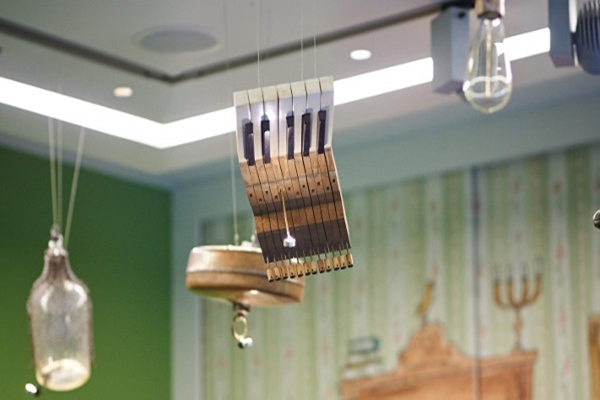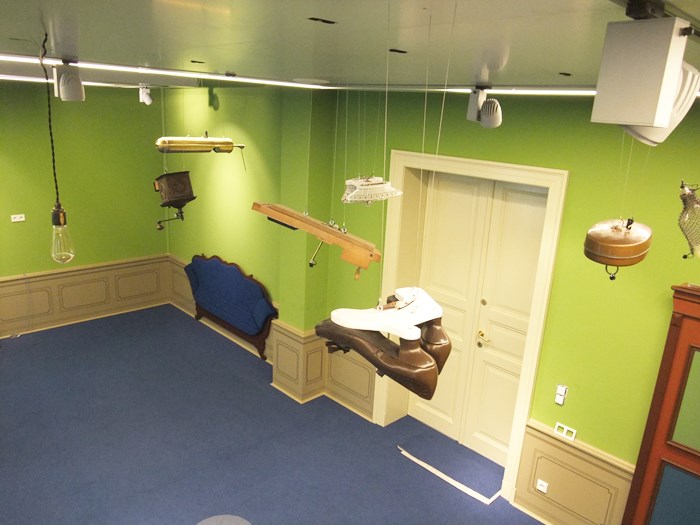Die zwölf an der Decke hängenden Gegenstände haben alle einen Bezug zur Zeit, in welcher Clara und Robert Schumann gelebt haben. Der Zeitraum ist
hierbei großzügig zu sehen - er bezieht sich nicht nur auf die Jahre 1840-1844, sondern allgemein auf das 19. Jh.
Tritt man nun unter eines dieser Objekte, so hört man verschiedene Geräusche und Töne in zufälliger Reihenfolge. Alle Klänge sind Aufnahmen, die durch
ein 4-Kanal-Lautsprechersystem wiedergegeben werden. Einzige Ausnahme: Der Telegraf - hier werden mehrere Schaltrelais live am Gerät ausgelöst, die die
klackenden Geräusche von sich geben. Ursprung und Beschaffenheit der Klänge folgen dabei einem von folgenden vier Prinzipien:
a) Das Gehörte ist direktes Produkt der Handhabung des ausgestellten Objektes. Man könnte es also am Objekt selbst nachspielen.
b) Das Gehörte ist ein Sinnbild des Gegenstandes, eine Assoziation
c) Das Gehörte ist eine Kombination aus beiden o.g. Kategorien
d) Das Gehörte hat nichts mit dem Objekt selbst zu tun. So im Falle der Glühbirne, denn Strom an sich klingt nicht. Das Gehörte wurde synthetisch am Computer
hergestellt und orientiert sich lediglich daran, mit welchem Klang viele von uns das Phänomen Strom verbinden würden.
Im Raum gibt es einen Schrank mit vier Türen. Jede geöffnete Tür startet ein anderes "Spiel" mit den Klängen. So kann man Orchesterwerke von Robert Schumann
hören mit dem Klang von Porzellan, Wärmflaschen, Backformen, Dampfpfeifen, Kaffeemühlen, Schritten und vieles mehr.
The twelve objects hanging from the ceiling are all related to the time in which Clara and Robert Schumann lived. The period
does not only refer to the years 1840-1844, but also covers the entire 19th century
If you now step under one of these objects, you will hear various noises and tones in a random order. All sounds are recordings made by a 4-channel
speaker system can be played back. The only exception: the telegraph - here several switching relays are triggered live on the device make clicking
noises. The origin and nature of the sounds follow one of the following four principles:
a) What is heard is a direct product of handling the exhibited object. So you could replay it on the object itself.
b) What is heard is a symbol of the object, an association
c) What is heard is a combination of category a) and b)
d) What is heard has nothing to do with the object itself. This is the case with the lightbulb, because electricity itself does
not make a sound. What was heard was synthetically produced on the computer and is based on the sound with which many of us
would associate the phenomenon of electricity.
In the room there is a wardrobe with four doors. Each opened door starts a different "game" with the sounds. This is how you can listen to
orchestral works by Robert Schumann. However, there are no classical instruments to be heard, but porcelain glasses, hot-water bottles,
baking pans, steam whistles, coffee grinders, footsteps and much more.

